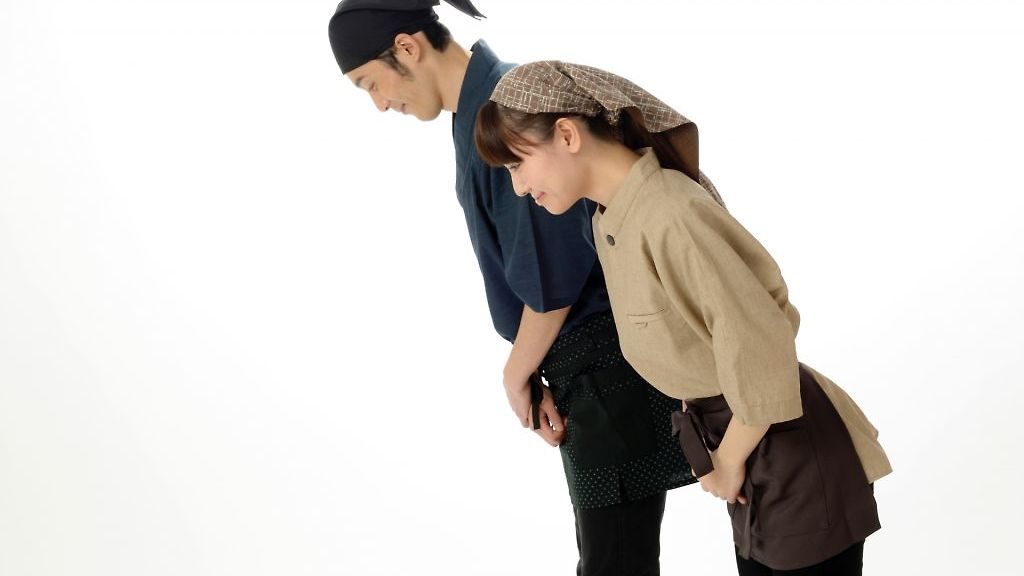What is “Ojigi”(bowing) without which you can’t get along with Japanese people?

This post is also available in 日本語
For Japanese people, “Ojigi” is a normal act in everyday life. For many foreigners who don’t have this custom, they are confused as to when, where and how to do this. “Ojigi” is a very important practice in communicating with others, just as greeting words are. We’ll introduce you to the meaning of and manners of “Ojigi” which you need to know for establishing relationships with Japanese people.
Contents
What is “Ojigi”? What is the meaning?
“Ojigi” is to bend your upper body forward towards your counterpart to show your respect, affection, gratitude or regrets. It is said that the origin of this act which exposes your neck, a vital part of your body, to the other means no hostility but trust on your part.
It usually accompanies greetings such as “Good morning.”, “Thank you for coming.” or “Sorry for ~~.” If the person is far out of your voice or your companion is talking, you can “Ojigi” with no word. However, you want be mindful that it may deemed to be impolite if you only say some greeting with no “Ojigi”.
When do you “Ojigi”?

“Ojigi” is a natural act of Japanese daily manner and we don’t count how many times we “Ojigi” in a day, but if you ever count, the number would be far more than you imagine. It’s a natural custom for Japanese but the following list shows situations where you need to “Ojigi”.
“Ojigi” situations
- To your boss and/or colleagues upon arriving or leaving office.
- To customers welcoming or seeing off.
- When visiting and leaving customers at their home or offices.
- At the beginning and the end of a class at the elementary and middle schools.
- When receiving a commendation.
- When entering other’s house, room or office.
- When introducing yourself at the first encounter.
- When happen to meet your acquaintance on the street or at restaurant.
- When presenting yourself in front of esteemed person.
- At the beginning of a martial art tournament or a ball game, to your opponents.
- At the beginning and the end of your speech, to the audience.
- When requesting something, to your counterpart.
- When you want to show gratitude.
- When you want to apologize.
If you are going to school or working, you do “Ojigi” many times in a day. If you are working at a restaurant or a department store, you’ll be doing “Ojigi” all day long.
The correct way to do “Ojigi”
When you do “Ojigi” you want to do this in a correct way, don’t you?
Please refer to the following.
- Stand facing the other party with a good straight posture.
- Cite your greeting words looking at eyes of the other.
- Bend upper torso keeping back and head straight.
Note: Your hands are placed on the side lines of trousers for man, on your frontwith right hand beneath left hand for woman.
Count 1and 2 when bending, take a breath, and raise your head slowly counting 3,4,5 and 6. - After straightening up, look at the other’s eyes.
Furthermore, when you do “Ojigi” to your customer in a corridor or other place, you have to stop walking. Otherwise, it will be a poor manner.
Only one “Ojigi” is enough. If you do repeatedly at the same time, the other person may feel very uncomfortable.
How deep you bend your torso-3ways

Now, you have learned what this “Ojigi” custom means, there are three kinds of “Ojigi” depending upon how much angle you bend from your waist. It might be difficult to understand the differences at first. You will be able to grasp what is the appropriate angle in each occasion by studying the Japanese people around you.
15degree “Ojigi” bow
This lightest “Ojigi” of the three is to show acknowledgement to customers not in your charge, when crossing in front of other people or when passing each other.
30degree “Ojigi” salute
This most common “Ojigi” is practiced at most ordinary occasions.
45~90degree “Ojigi”,the most respectful salutation
This is the politest of the three by bowing deeply. You take this form at a weddingor a funeral and to express your sincere gratitude or deepest apology.
You’ll be fondly accepted by mastering “Ojigi”.
“Ojigi” is a necessity in Japanese communications. It’s not an overstatement that who masters the“Ojigi” practice would take control of the relationships among Japanese people. Japanese tend to value highly the courtesy. We wish you acquaint yourself with and make good use of “Ojigi”,a Japanese custom, and establish a solid and amicable relationships with Japanese people.
- Will You Get a Perfect Score? Test Your Knowledge of Japanese Dining Etiquette!
- Can You Answer All The Questions?[Résumé Quiz] – Reasons For Applying, and More (Part 2)
- Don’t Make These Mistakes! 6 Important Business Manners at Work
- How Many Can You Answer? [Résumé Quiz] – Pictures, Information, and More (Part 1)
- [Explained by a Legal Professional] Points to consider when you wish to work in Japan









